The biggest trend in medicine over the past 20 years has been evidence-based practice, the idea that medical providers of all types should stick to what the data shows when making decisions. on the treatments to follow.
The problem is that the evidence keeps changing as researchers gradually expand the circle of knowledge in each discipline. Health care providers must therefore engage in endless change.
That’s the idea behind the new $70 million Sharp Prebys Innovation and Education Center, a state-of-the-art four-story dedicated training venue Friday at Kearny Mesa.
“It will be a place where the people at Sharp will forge, foster and develop solutions to some of the biggest challenges we have today, how to make the patient experience more seamless, more enjoyable and, in doing so, how to reduce the cost of care for the patient,” said Chris Howard, Managing Director of Sharp HealthCare. “It’s a place where we can generate those ideas and concepts and bring them to life.”
Although there is a large new auditorium, cafeteria and meeting rooms located on the ground and top floors of the center, the real action takes place on the second floor. This is where both the nursing and clinical simulation rooms reside, offering a series of realistic patient rooms where healthcare professionals of all types can congregate to learn everything from unusual birth presentations to announcing difficult news to patients.
There is a wide range of medical simulators connected to a long hallway control room with a wide expanse of windows allowing exercisers to see what is happening without getting in the way. Video cameras and microphones are also installed throughout, allowing simulations to be recorded and then replayed in debriefing rooms where teams can review what worked, what didn’t and why. .
Patients might wonder what they get out of this space, given that they will never visit it. The patients here are either animatronics or actors trained to show symptoms of illnesses they don’t actually have.
Carmen Spalding, director of simulation and innovative learning at Sharp, explained that as teams prove every day in the field, practice is everything. It’s best to do things right before the game starts. Something like a breech birth doesn’t happen every day, so bringing in a team to practice the skills they’ll need can pay off, especially when the best results are achieved when a whole team of people is able to work seamlessly with little warning.
“The learning doesn’t end when you graduate,” Spalding said. “We’ve seen several studies that have shown that using simulation can improve patient outcomes, and that’s what it’s all about, delivering the best care.”
Medical simulation is far from a new concept in San Diego. Spalding came from the Naval Medical Center in San Diego, where she participated in that organization’s training efforts using similar methods. The UC San Diego School of Medicine has also been heavily involved in using simulation to train medical students and also to train high-tech medical devices such as surgical robots.
The Sharp center, however, exemplifies a growing trend in medicine toward large health systems investing heavily in building their training capabilities. Today’s competition for healthcare workers makes in-house training capability a competitive advantage.
